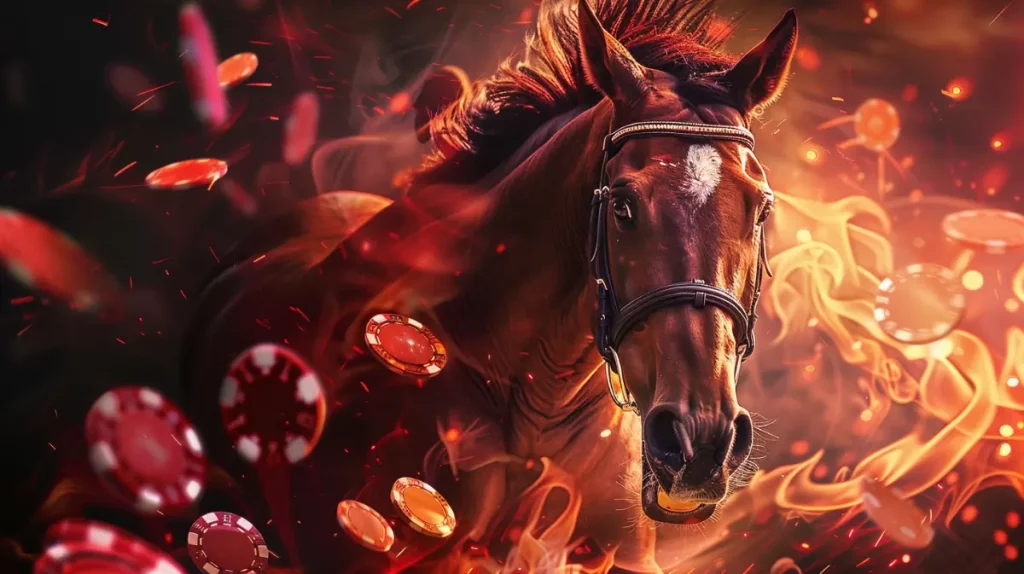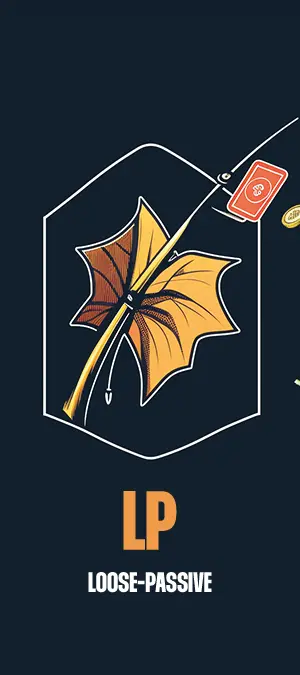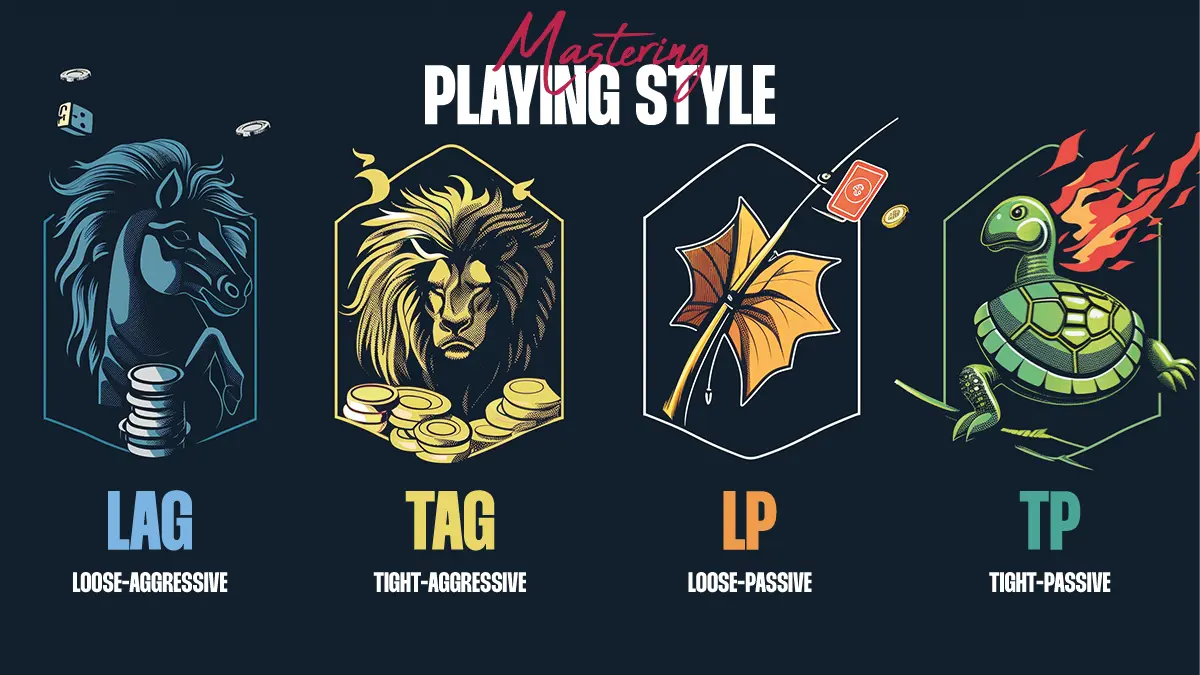Introducción a los estilos de juego en el póker
El póker no es sólo un juego de cartas: es una batalla de ingenio, estrategia y personalidad. Tu estilo de juego es tu estrategia de guerra en el ámbito del póker, un reflejo de tu enfoque, tus decisiones y, en última instancia, tu éxito en la mesa.
Ya seas un jugador cauteloso que calcula meticulosamente cada movimiento o un arriesgado que prospera bajo presión, entender los diferentes estilos de juego del póker es crucial.
Esta guía profundiza en el corazón del campo de batalla estratégico del póker, explorando los cuatro estilos principales de juego: Tight-Aggressive (TAG), Loose-Aggressive (LAG), Tight-Passive (TP) y Loose-Passive (LP), y más allá.
Al reconocer estos estilos, incluidos los apodos únicos y las estrategias de los mejores jugadores de póker, obtendrás ideas para dar forma a tu juego y a la guerra psicológica en el tapete.
¡Mezclémonos y adentrémonos en el mundo de los estilos de juego del póker!

Los cuatro principales estilos de juego del póker
Los estilos de juego del póker son tan diversos como los jugadores en la mesa, cada uno con su enfoque único para el juego.
Entender estos estilos no se trata solo de saber cuándo apostar o retirarse; se trata de entender a tus oponentes y a ti mismo.
Aquí desglosamos las características principales de cada estilo.
Tight-Aggressive (TAG) : ajustado-agresivo


Tight-Aggressive (TAG) : ajustado-agresivo
La paciencia alimenta el poder.
Los jugadores Tight-Aggressive (TAG) seleccionan pocas manos pero las juegan de manera agresiva. Conocidos por los riesgos disciplinados y calculados, los TAGs mantienen una fuerte imagen en la mesa, aprovechando su rango ajustado para jugar de manera rentable y asertiva. Ideal para jugadores que prefieren un enfoque estratégico y controlado, maximizando las ganancias desde posiciones fuertes mientras minimizan las pérdidas.
Estadísticas comunes
VPIP
20-25%
PFR
18-22%
af
3.0-4.0
El jugador Tight-Aggressive es el francotirador del mundo del póker, esperando pacientemente el momento adecuado para atacar. Los TAG juegan una selección limitada de manos, pero cuando lo hacen, apuestan y suben de forma agresiva.
Este estilo se trata de control y precisión, aprovechando al máximo las manos fuertes y no desperdiciando fichas en manos especulativas.
The advantage of this style is its predictability in a good way; opponents know you only play solid hands, which can make them hesitant to enter a pot you’re invested in.
However, the TAG style also requires discipline and the ability to fold when you’re not in a strong position.
Los grandes del póquer encarnan el estilo TAG
Flojo-Agresivo (LAG)


Flojo-Agresivo (LAG)
El caos crea oportunidades.
Los jugadores Loose-Aggressive abrazan el riesgo, jugando una amplia variedad de manos con apuestas agresivas. Esta imprevisibilidad puede dominar la dinámica de la mesa, obligando a los oponentes a tomar decisiones difíciles. Los LAG prosperan creando presión y explotando debilidades, adecuado para jugadores habilidosos que pueden manejar la alta varianza y adaptarse rápidamente.
Estadísticas comunes de un jugador flojo-agresivo
VPIP
30-40%
PFR
25-35%
af
4.0+
In contrast, the Loose-Aggressive player is the berserker at the table, using aggression and unpredictability as their main weapons. LAGs play a wide range of hands, often putting pressure on their opponents with bets and raises. This style can be highly effective in creating a dynamic table image and capitalizing on opponents’ hesitations and mistakes. The key to mastering the LAG style is knowing when to dial back the aggression and not let the loose play turn into recklessness.
Jugadores icónicos que apoyan el enfoque LAG.
Tight-Passive (TP)


Tight-Passive (TP)
La constancia gana carreras.
Los jugadores Tight-Passive son conservadores, optando por una gama limitada de manos fuertes sin apuestas agresivas. Este enfoque de bajo riesgo minimiza las pérdidas potenciales pero también limita las ganancias. Ideal para principiantes, los TP se centran en manos sólidas, aunque corren el riesgo de ser superados por estrategias más agresivas.
Estadísticas comunes de un jugador Tight-Passive
VPIP
15-20%
PFR
10-15%
af
1.0-2.0
The Tight-Passive player, often referred to as the “Rock,” prefers a conservative approach to the game. TPs play a limited number of hands and tend to check or call rather than bet or raise. This style minimizes risk and avoids putting too many chips in the pot without a strong hand. While it can be a safe way to play, it also means missing out on opportunities to maximize winnings from strong hands or to bluff opponents out of pots.
Estrategas renombrados que prefieren el juego Tight-Passive.
Loose-Passive (LP)


Suelto-pasivo (TP)
Disfrutar por encima de dominar.
Los jugadores pasivos-flojos participan en muchas manos pero rara vez toman la iniciativa en las apuestas. Prefiriendo igualar en lugar de subir, los LPs apuntan a ver muchos flops pero a menudo no capitalizan en manos fuertes. Este enfoque es menos competitivo, lo que lleva a una pérdida gradual de fichas contra oponentes más agresivos.
Estadísticas comunes de un jugador flojo-pasivo
VPIP
30-50%
PFR
10-20%
af
1.5-
Finally, the Loose-Passive player, or the “Whale,” enjoys playing many hands but typically opts for checking and calling. This style is the least aggressive and can often lead to donating chips to more assertive players. LPs enjoy the social aspect of poker and the thrill of seeing flops but may struggle to turn a profit over the long term without the aggression needed to protect their hands or bluff effectively.
Figuras memorables con una táctica suelta-pasiva
This style is less commonly associated with top professional players, as it’s generally considered a less profitable way to play the game at high levels. However, some recreational or amateur players with significant bankrolls who’ve made waves in high-stakes games might fit this description, but they are not typically considered “legends” of the game.
Apodos y personalidades coloridas en el póker
Poker is as much about the people as it is about the cards. Over the years, players have earned nicknames that reflect their playing styles, adding a rich tapestry of characters to the poker world. “Rocks” are solid and unmovable, embodying the tight-passive approach with a discipline that can be both admirable and exploitable. “Maniacs,” on the other hand, take the LAG style to its extreme, betting and raising in a whirlwind of aggression that can unsettle even the most experienced players.
“Sharks” are the predators of the poker ecosystem, adapting their style to exploit the weaknesses of their opponents, whether that means playing tight-aggressive against passive players or switching to a loose-aggressive approach to dominate tighter tables. “Fish” are the prey, often new or inexperienced players who haven’t yet refined their strategy, making them easy targets for the sharks.
Understanding these nicknames and the personalities behind them is crucial for navigating the poker world. Recognizing a “Rock” at your table means knowing they’re unlikely to bluff, while spotting a “Maniac” means bracing yourself for a rollercoaster of raises. Adapting your play to exploit these personalities can be the key to your success at the tables.
Estilos de juego de los mejores jugadores de póker del mundo
The legends of poker aren’t just known for their winnings but for their unique styles that have left an indelible mark on the game. Daniel Negreanuconocido por su increíble capacidad para leer a sus oponentes, adopta un enfoque flexible, pasando de un estilo a otro cuando es necesario. Phil IveyConsiderado a menudo como el mejor jugador polivalente, utiliza un estilo muy agresivo para dominar a sus adversarios, combinando la paciencia con una agresividad letal.
Phil Hellmuth, the “Poker Brat,” is famous for his tight play and explosive temperament, which he uses to unsettle opponents while waiting for premium hands. On the other end of the spectrum, Tom Dwan, a player from the online generation, showcases the power of the loose-aggressive style, applying pressure and challenging traditional notions of “correct” play.
Estudiar a estos jugadores revela un tema común: el dominio de su estilo elegido y la capacidad de adaptarse a la dinámica de la mesa. Para los aspirantes a jugadores de póker, la lección es clara: encontrar un estilo que se ajuste a tu personalidad y objetivos es crucial, pero también lo es la flexibilidad para ajustar tu enfoque según tus oponentes y la situación actual.
Cómo elegir su estilo de juego en el póquer
Elegir un estilo de juego de póquer es una decisión muy personal que debe reflejar su nivel de comodidad, comprensión estratégica y habilidades para la guerra psicológica. Para los principiantes, empezar con un enfoque tight-agresivo puede proporcionar una base sólida, enseñando disciplina y la importancia de la posición y la selección de manos. A medida que se adquiere experiencia, experimentar con elementos del estilo suelto-agresivo puede añadir versatilidad al juego.
La clave es mantenerse fiel a tus instintos mientras estás abierto al crecimiento y al aprendizaje. El póker es un juego de aprendizaje perpetuo, y los jugadores más exitosos son aquellos que continuamente perfeccionan sus estrategias y se adaptan a nuevos desafíos.
Cómo adaptar su estilo a los distintos juegos de póquer
Poker comes in many forms, from the fast-paced action of No-Limit Hold’em to the strategic depths of Pot-Limit Omaha and beyond. Each variant demands a slightly different approach, and the mejores jugadores de póquer son los que pueden ajustar su estilo para adaptarse al juego en cuestión.
In No-Limit Hold’em, a tight-aggressive style can be particularly effective, leveraging the power of big bets to protect your hands and apply pressure. In contrast, Pot-Limit Omaha often rewards a more loose-aggressive approach, given the greater potential for drawing hands and the importance of aggression in building pots for your big hands.
Adaptar tu estilo también significa ajustarse a las tendencias de tus oponentes. En una mesa llena de jugadores agresivos, adoptar un enfoque más conservador puede dar frutos, mientras que enfrentarse a oponentes pasivos podría requerir aumentar la agresión para capitalizar su vacilación.
Conclusión
Understanding and mastering poker playing styles is a journey, not a destination. The most successful players are not those who rigidly adhere to a single style but those who adapt, learn, and grow with each hand dealt. Whether you’re a TAG, LAG, TP, or LP, the key to success lies in understanding the strengths and weaknesses of your style and evolving your strategy to stay one step ahead of the competition.
El póquer es un juego de infinita complejidad y matices, y tu estilo de juego es tu firma personal en el juego. Acéptalo, perfecciónalo y deja que te guíe hacia la victoria en las mesas.

